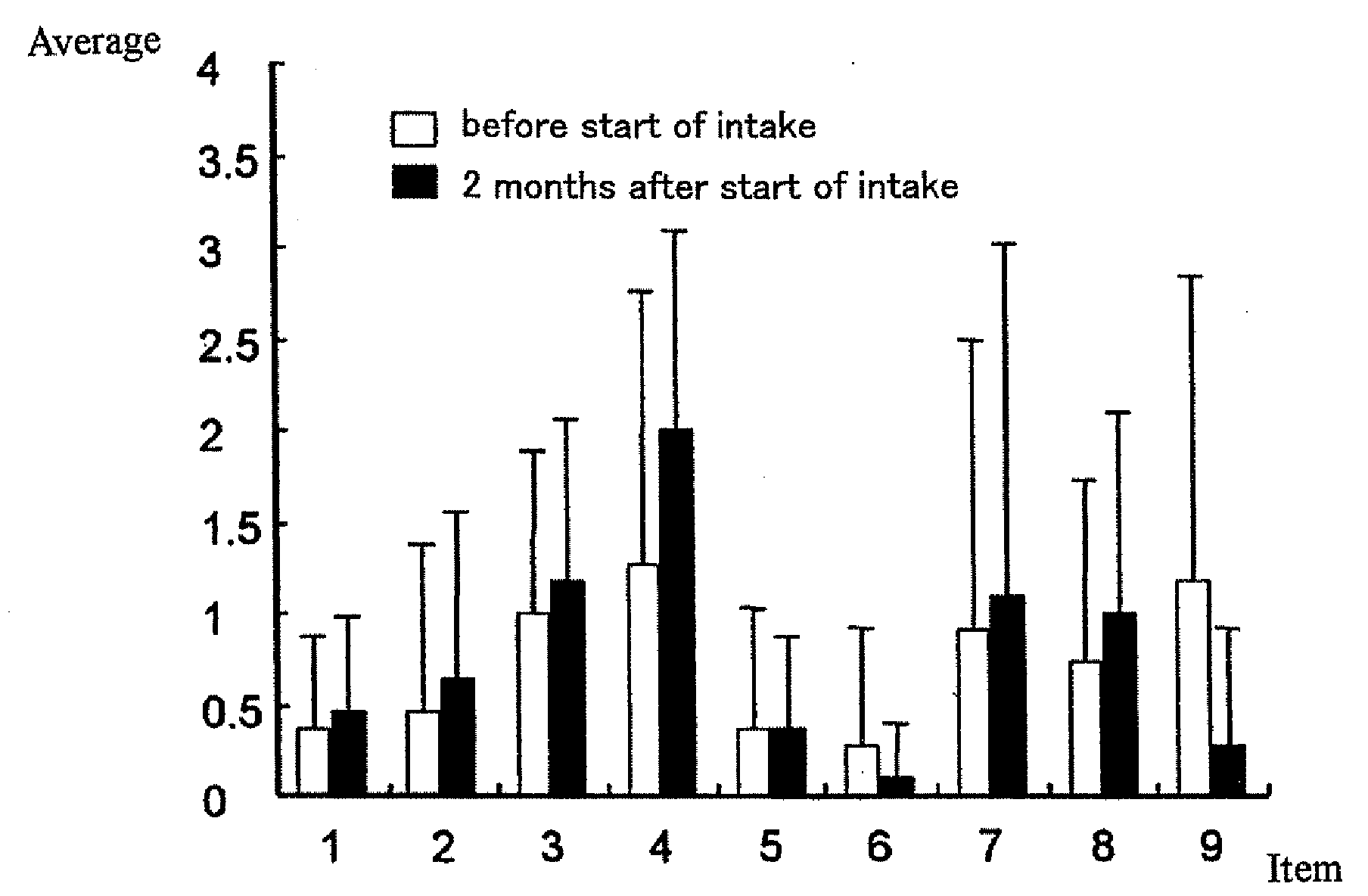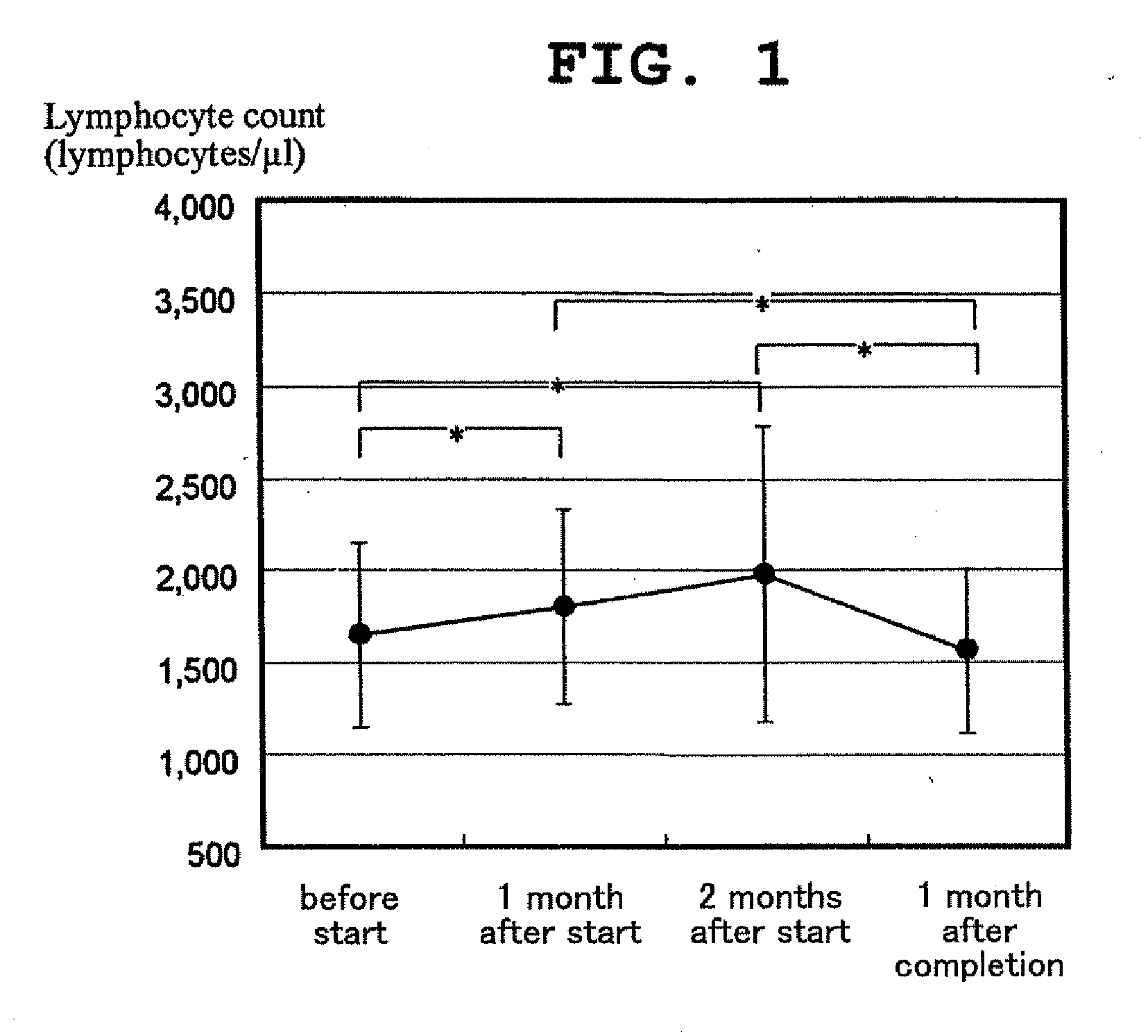Method of Increasing Peripheral Blood Lymphocytes
a peripheral blood and lymphocyte technology, applied in the field of increasing peripheral blood lymphocytes, can solve the problems of chronic decrease in the circulating lymphocyte count, poor immune system, and low cytokine use, and achieve the effect of increasing the lymphocyte count, being economical and stable, and being new
- Summary
- Abstract
- Description
- Claims
- Application Information
AI Technical Summary
Benefits of technology
Problems solved by technology
Method used
Image
Examples
example 1
[0059]Monosodium glutamate monohydrate was added to rice gruel to 0.5 wt %.
[0060]Hospitalized elderly test subjects (n=11 (2 males, 9 females), average age of 85.8±8.2, average body weight of 39.7±5.7 kg), were fed the above-mentioned rice gruel with glutamic acid 3 times a day for 2 months, establishing a continuous administration of 0.8 g on average of monosodium glutamate monohydrate per meal.
[0061]From 1 month before the start of administration to 2 months after the start of administration, the eating ratio (ratio of weight of food actually eaten to weight of provided food) was measured. Blood samples were collected early in the morning immediately before the start of administration, 1 month after the start of adminstration, 2 months after the start of administration, and 1 month after the completion of administration, and the blood indices were measured. In addition, the body weight was measured.
[0062]There was no significant difference in the eating ratio after the start of ad...
example 2
[0065]Table 1 shows the composition of 4,000 g of enteral nutrient (PEG agent) containing glutamic acid.
TABLE 1amountname of materialusedunitmilk protein source material (casein 66.8 wt %)416gmonosodium glutamate (1 hydrate)24gdextrin1040ggranulated sugar68gwater-soluble food fiber117gsodium phosphate10.4gpotassium phosphate9.2gmagnesium chloride23.6gcalcium lactate12.8gpotassium citrate24gsodium gluconate80gsodium ferrous citrate0.84g*mineral yeast Mix3.3g**vitamin Mix2.6gsodium ascorbate2.2gsodium erythorbate2.2gflavor4gedible fat and oil213gemulsifier11.2g*mineralzinc yeast1492mgyeast Mixcopper yeast748mgselenium yeast266.8mgmanganese yeast724mgiodine yeast92.4mg**vitaminvitamin A powder (175000 IU / g)167.6mgMixβ-carotene (1.5% powder)712mgvitamin D3 powder (200000 IU / g)9mgvitamin E powder (20% powder)260mgvitamin K2 (0.2% powder)160mgthiamine hydrochloride14.88mgpyridoxine hydrochloride10.52mgriboflavin sodium phosphate10.32mgnicotinamide80mgcalcium pantothenate55.2mgcyanocobalam...
example 3
[0069]In the test of Example 1, the test subject was assessed by a nurse or a care assistant for the improvement of the general condition between immediately before the start of the administration of the rice gruel containing a salt of glutamic acid e and 2 months thereafter. The results are shown in Table 2. The test subjects took the Hasegawa Dementia Scale-Revised for the following 9 items immediately before the administration and 2 months thereafter. The results are shown in FIG. 3.
[0070]1. age?
[0071]2. what year, what month, what date, what day of the week?
[0072]3. where are you now?
[0073]4. memory of 3 words
[0074]5. continue to subtract 7 from 100
[0075]6. say numbers in reverse order
[0076]7. read out from memory of item 4
[0077]8. memory of 5 goods
[0078]9. say name of vegetables.
[0079]As is clear from Table 2, almost all test subjects showed a tendency toward improvement of mind and body conditions such as speech recovery, expression of emotion, and the like. In the Hasegawa De...
PUM
| Property | Measurement | Unit |
|---|---|---|
| wt % | aaaaa | aaaaa |
| body weight | aaaaa | aaaaa |
| weight | aaaaa | aaaaa |
Abstract
Description
Claims
Application Information
 Login to View More
Login to View More - R&D
- Intellectual Property
- Life Sciences
- Materials
- Tech Scout
- Unparalleled Data Quality
- Higher Quality Content
- 60% Fewer Hallucinations
Browse by: Latest US Patents, China's latest patents, Technical Efficacy Thesaurus, Application Domain, Technology Topic, Popular Technical Reports.
© 2025 PatSnap. All rights reserved.Legal|Privacy policy|Modern Slavery Act Transparency Statement|Sitemap|About US| Contact US: help@patsnap.com



